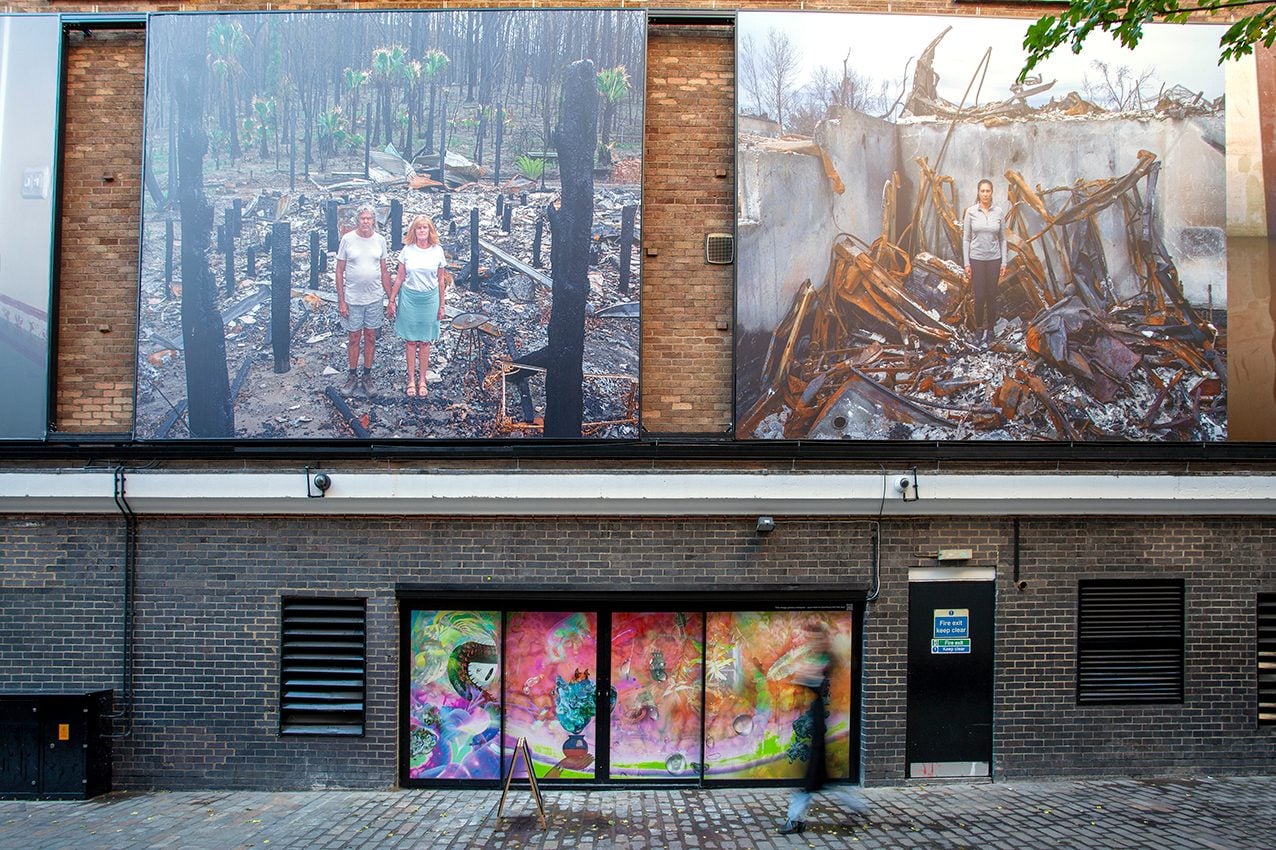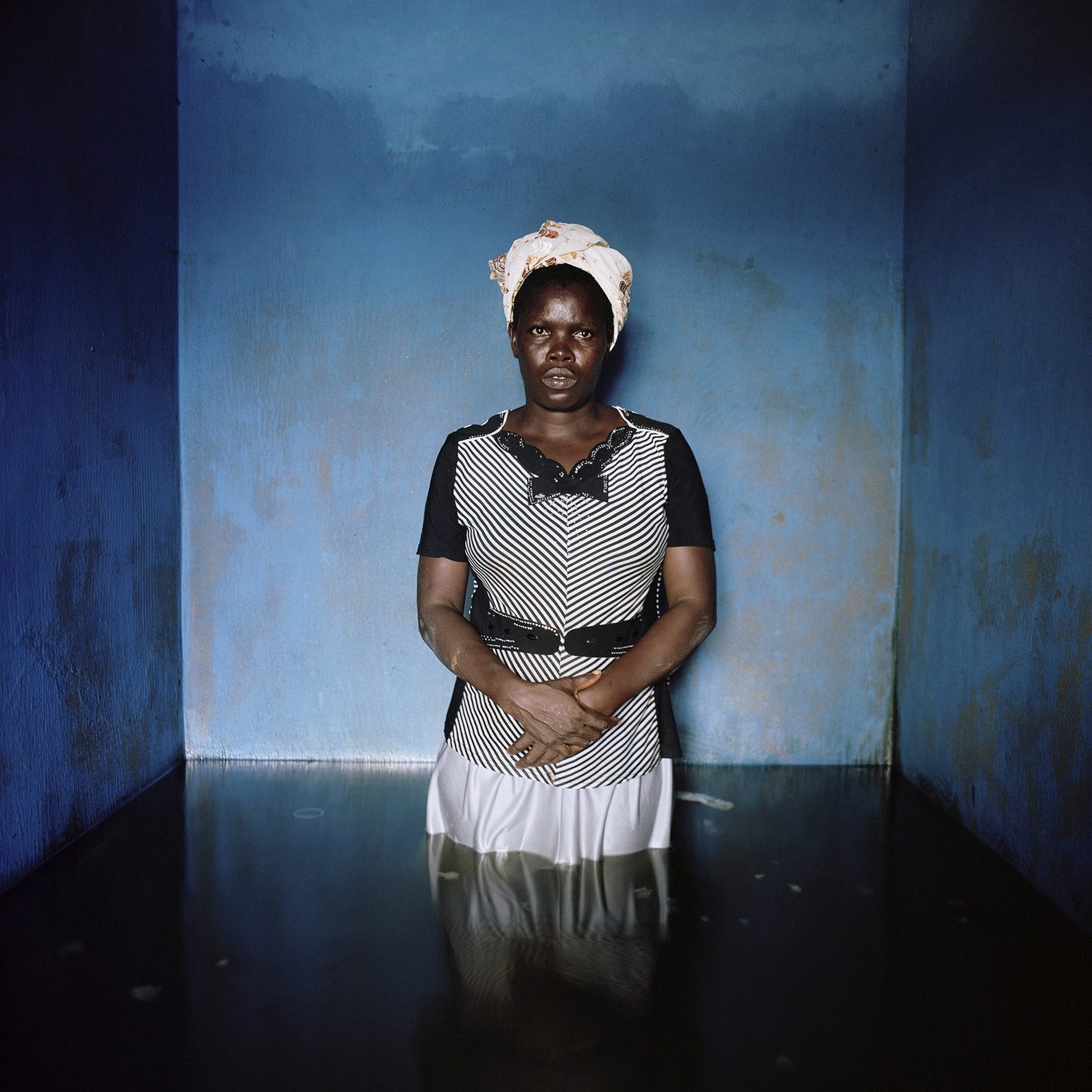The first time South African photographer Gideon Mendel photographed a flood, it was 2007. Living in the UK, he had young children at the time, and found himself thinking a lot about the world they would be growing up into. What would it look like 10, 20, 30 years from now? Of course, this kept bringing him back to the subject of climate change, and he began to wonder about the ways it could be visualized through photography.
“I found myself searching for images on sites like Flickr and, back then, [the narrative] was dominated by images of glaciers and polar bears and beautiful, remote places which made me feel frustrated that the imaging of climate change seemed so far away and so disconnected from people,” he recalls. “I wanted to find a way of talking about climate change which was confrontational but different to the conventional photojournalistic response—I wanted to work in the space of activism and visual advocacy, and I wanted people to be looking climate change directly in the eye.”
In 2007, there had been devastating floods in Doncaster (a city in England’s South Yorkshire region) and Mendel took a couple of trips there. “At that time I was independently experimenting with portraiture using a Rolleiflex camera. I don’t quite remember how it happened, but I hit upon this idea of making portraits of people in the flooded environments—in the water—and it just really hit a chord.”
He remembers showing this work to Fiona Shields, Head of Photography at the Guardian, and her responding strongly to it. “She helped to spread those pictures and within a few weeks I was working with ActionAid, photographing floods in India. I went there and did the same thing as in Doncaster and then when I got back I put these pictures side by side, portraits from floods in the UK and India, and I felt like something quite strong was happening—a shared vulnerability, despite the huge differences in wealth, culture and environment. That was the beginning of the journey for me.”

Mendel finds people to photograph in various ways. “I always work with someone local to help me connect with people, and sometimes use social media too,” he explains. And when shooting, no matter the subject or environment, he says he is always looking for a deeper connection, through the camera, with the people and the places he photographs. He is acutely aware of the ethical conundrum of entering communities he isn’t from and telling stories on their behalf, but he always tries to collaborate with the people he meets, bearing witness to their lived experiences in meaningful ways via the exchange that happens between photographer and those that are photographed.
“I don’t want to portray any of the people I photograph as victims,” he says. “I think it’s about approaching situations with confidence and compassion and in these kinds of situations, where people have been traumatizsed by their experiences, it’s very important for me that the experience of being photographed is a good one for them. The heart of good portraiture is the person you are in relation to your subjects.”

Since 2007, Mendel has travelled to document flood zones in 13 different countries—the UK, India, Haiti, Pakistan, Australia, Thailand, Nigeria, Germany, The Philippines, Brazil, Bangladesh, the US and France—and in each of these places, he has photographed every person in the same way, compositionally mirroring those first pictures he took in Doncaster: bodies half-immersed in the water, the floodline becoming like a continuous thread that weaves people and communities and cultures together in experience. Then, at some point, he began taking other types of pictures too, and so he named the overall project Drowning World, organizing his images into sub-series that each explore a different aspect of the destruction that flooding causes.

This allowed the photographer to explore different visual approaches, teasing out the complex layers of the disasters he was encountering. One of these sub-series, Floodlines, records the swell of water into homes and public spaces through images of the new horizon the water makes in the environment. Shot with abstract and graphic sensibilities, these pictures are powerful because of their viscerality. And then there is the Watermarks series, in which Mendel has collected more than 2000 water-damaged family pictures that he’s encountered on location. Some of them are unknown faces to him, while others are people he photographed. This third series adds yet another layer, with the water having left marks like bruises or wounds upon the surfaces of these past memories.

By 2020, having shot the devastation of floods for some 13 years, Mendel then decided to start a new, related project entitled Burning World—this time documenting the ever-increasing ferocity of wildfires across the world as temperatures soar. Having travelled to Australia, Greece, Canada and the US for this work so far, Mendel initially had the idea to work in an aesthetically similar way to Drowning World, but it soon became clear to him that this was an altogether different endeavour. Water and fire are both environmentally shaping forces, but where Mendel was able to enter flooded environments before the water has receded to visually document its presence, in the case of wildfires it is always in the aftermath he arrives—no burning flames, just the traces of what’s left after this powerful force has torn through. “It’s a very different visual challenge,” he says.

Nevertheless, he found a way to create a uniformity of portraiture in Burning World, this time in a sub-series of pictures entitled Portraits in Ashes, in which we see people photographed in the same way, all framed by the remains of their burned houses. Elsewhere, other sub-series in this project include: Scorched Topographies, a series of landscape pictures revealing the haunting remains of charred land; Burnt Textures, a series of visual studies of the impact flames have had on surfaces and things; Olive Ghosts, a set of tree portraits, detailing the gnarled remains of burned olive trees, lingering like spectres on the Greek island of Evia; and Climate Artifacts, a series of burnt objects Mendel collected from the rubble and photographed in a studio setting, with a white background, like forensic, still life shots.

In both Drowning World and Burning World, what resonates the most is the emergent emotive constellation of different narrative threads. While in both cases, the portraits are what Mendel calls “the spine of the project,” the additional, interrelated series reveal all the extra ways he has immersed himself into disaster environments and felt around the edges of what he sees. For us viewers, they create a rich tapestry of ways that help us understand a little of the true extent of the disasters at hand—of their insidiousness—by showing us how a single event can swell and fracture outwards in endless directions, seeping into every area of life.

The two series are currently being brought together at The Photographers’ Gallery in London, in an arresting outdoor exhibition taking over the Soho Photography Quarter. Entitled Fire/Flood, it includes a 40 metre long display of images and banners as well as a projection of a new film. Screened at dusk everyday and shown through until dawn, the film is a scored atmospheric odyssey through some of the environments we see in the pictures, activating those spaces by showing people wading through flood water or picking through the burnt rubble of their former homes.
Some people row us through the water in boats, while at other times we see the aftermath of fire from a car window, slowly cruising past it. Meanwhile, some scenes are like moving portraits, and we find the camera completely still, people posed before it as if for a picture—the only giveaway of it being a moving image is the subtle breeze moving through their clothes, or the rain falling around them.

Showing until Autumn 2023, this physical iteration of Fire/Flood is important for a number of reasons. Firstly, due to its location just off of London’s famous shopping destination, Oxford Street. “Because this work is so driven by activist impulses, it’s hugely appropriate to have it in conversation with all the chaotic advertising of the area, and it makes the pictures read in some ways like billboards, even though they are so different,” he says.
What’s been particularly rewarding for him is to see how confronting his work is in this environment—people wander past in their thousands every day, and yet many stop and find themselves transfixed by what they’re seeing, these images of devastation jarring among the glossiness of consumerism. It’s a powerful juxtaposition between cause and effect; fashion is one of our most damaging industries when it comes to the climate emergency.

Secondly, the resounding importance of this show lies in the immediacy of it. “A sensible photographer finishes a body of work and then they exhibit it. But I haven’t worked like that,” Mendel laughs. “While some of the pictures in this exhibition were taken many years ago, others—such as the ones from Pakistan’s Sindh Province and the Bayelsa State in Nigeria—were taken far more recently, between September to November of last year. “One of the images was even taken just 10 days before the show opened,” he says. “I’ve had many exhibitions of this work and I use each one to reflect on it, so it’s been really interesting to see how the work has grown in response every time.” In the end, it feels right for this work to be ever-evolving, just like the state of the world.
Editor’s note: Fire / Flood is on view until September 23, 2023 at Soho Photography Quarter in London.


